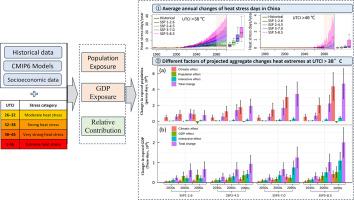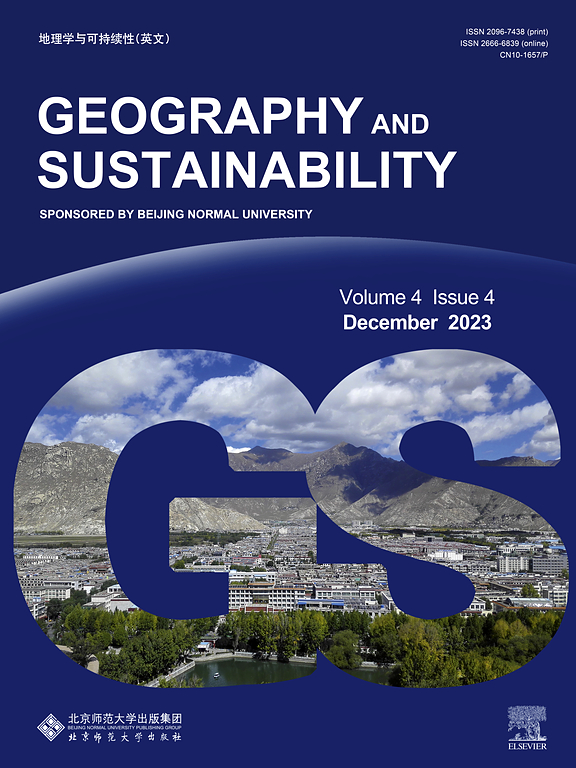中国日益加剧的极端高温社会经济暴露:基于cmip6的跨区域和情景未来热浪分析
IF 8
1区 环境科学与生态学
Q1 GEOGRAPHY, PHYSICAL
引用次数: 0
摘要
未来中国各地热浪频率和强度的增加将加剧对社会和环境的不利影响。然而,社会经济风险的变化仍未得到充分探讨。本研究利用耦合模式比对项目第6阶段(CMIP6)的气候模式输出,结合人口和国内生产总值(GDP)预测,研究了在4种共享社会经济路径(SSP)情景(SSP1-2.6、SSP2-4.5、SSP3-7.0和SSP5-8.5)下3个时期(2021-2040、2051-2070和2081-2100)中国及其8个子区域的热应力和社会经济暴露预测。我们的研究结果表明,在所有情景下,通用热气候指数(UTCI)都呈持续上升趋势,并随着时间的推移而加剧,在6°C时达到峰值。这表明中国的极端高温事件(EHEs)数量持续增加。在四个UTCI阈值(> 26°C、> 32°C、>; 38°C和>; 46°C)上,人群暴露于EHEs呈增加趋势。预估表明,到2081-2100年,在SSP5-8.5下,与当前水平相比,全国范围内将增加~ 14倍,西北地区(NWC)将增加500倍,西南地区(SWC2)将增加1000倍。在SSP3-7.0和SSP5-8.5下,东部和东南部地区,特别是长江三角洲和珠江三角洲地区的GDP暴露显著增加。在严重情景下,人口暴露主要受气候影响驱动,而GDP暴露则受相互作用影响,特别是在SSP5-8.5情景下和本世纪90年代。本研究的发现为中国不同地区的针对性适应提供了可操作的见解。本文章由计算机程序翻译,如有差异,请以英文原文为准。

Escalating socioeconomic exposure to extreme heat in China: A CMIP6-based analysis of future heatwaves across regions and scenarios
The future increased frequency and intensity of heat waves (HWs) across China will exacerbate adverse effects on society and the environment. However, changes in socioeconomic exposure remain underexplored. In this study, climate model outputs from the Coupled Model Intercomparison Project Phase 6 (CMIP6), together with population and gross domestic product (GDP) projections were used to investigate projected heat stress and socioeconomic exposure across China and its eight subregions under four shared socioeconomic pathway (SSP) scenarios (SSP1–2.6, SSP2–4.5, SSP3–7.0, and SSP5–8.5) over three periods (2021–2040, 2051–2070, and 2081–2100). Our results indicate a consistent upward trend in the Universal Thermal Climate Index (UTCI) across all scenarios, with intensifying increases over time, peaking at > 6 °C. This suggests a continuous increase in the number of extreme heat events (EHEs) in China. Population exposure to EHEs across the four UTCI thresholds (> 26 °C, > 32 °C, > 38 °C, and > 46 °C) shows an increasing trend. Projections indicate a ∼14-fold increase nationwide, 500-fold increase in Northwest China (NWC), and a 1000-fold in Southwest China (SWC2) under SSP5–8.5 by 2081–2100 compared with current levels. The eastern and southeastern regions, especially the Yangtze River and Pearl River Delta, show significant GDP exposure increases under SSP3–7.0 and SSP5–8.5. Population exposure is mainly driven by climatic effects under severe scenarios, whereas GDP exposure is influenced by interaction effects, particularly under SSP5–8.5 and during the 2090s. This study’s findings offer actionable insights for targeted adaptation in China’s diverse geographies.
求助全文
通过发布文献求助,成功后即可免费获取论文全文。
去求助
来源期刊

Geography and Sustainability
Social Sciences-Geography, Planning and Development
CiteScore
16.70
自引率
3.10%
发文量
32
审稿时长
41 days
期刊介绍:
Geography and Sustainability serves as a central hub for interdisciplinary research and education aimed at promoting sustainable development from an integrated geography perspective. By bridging natural and human sciences, the journal fosters broader analysis and innovative thinking on global and regional sustainability issues.
Geography and Sustainability welcomes original, high-quality research articles, review articles, short communications, technical comments, perspective articles and editorials on the following themes:
Geographical Processes: Interactions with and between water, soil, atmosphere and the biosphere and their spatio-temporal variations;
Human-Environmental Systems: Interactions between humans and the environment, resilience of socio-ecological systems and vulnerability;
Ecosystem Services and Human Wellbeing: Ecosystem structure, processes, services and their linkages with human wellbeing;
Sustainable Development: Theory, practice and critical challenges in sustainable development.
 求助内容:
求助内容: 应助结果提醒方式:
应助结果提醒方式:


